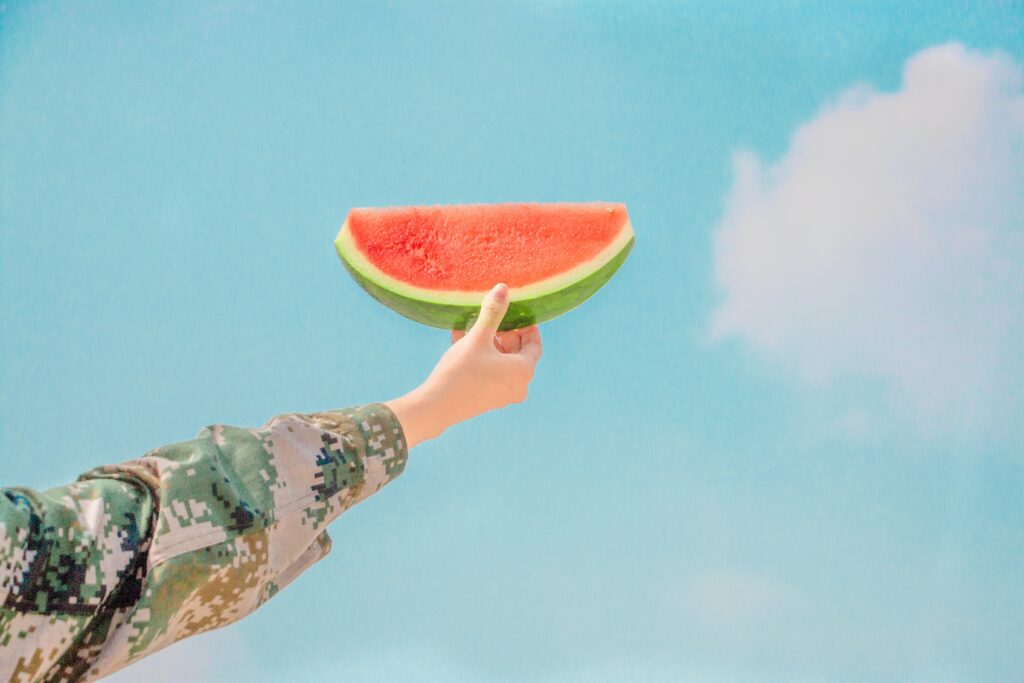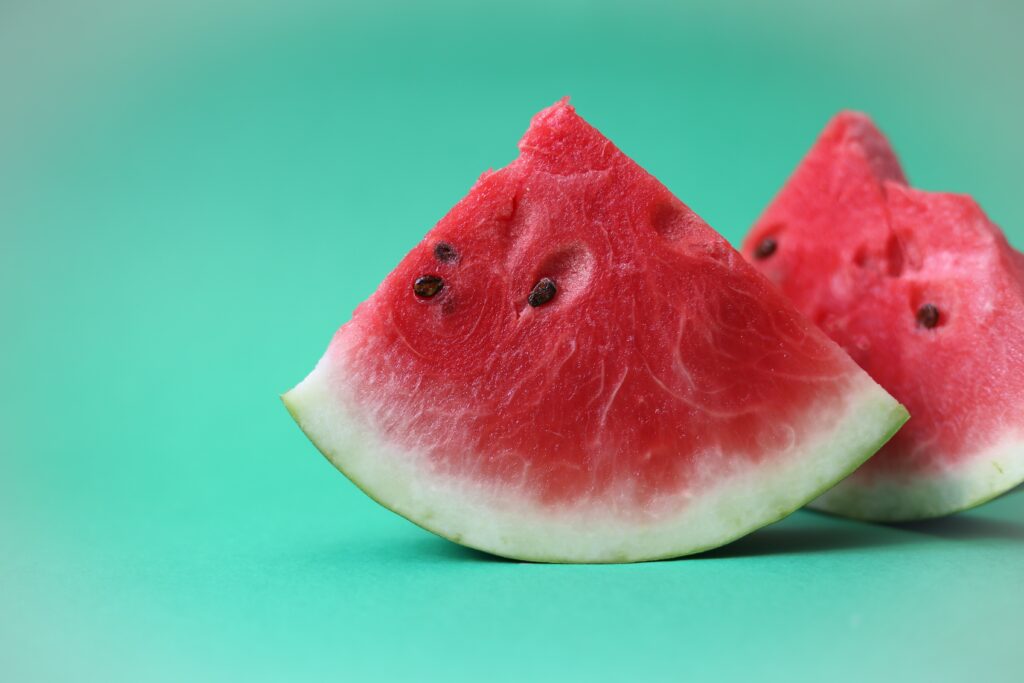Some of the links on this page are affiliate links, which means that Buzzy Kitchen earns commission from purchases made – at absolutely no extra cost to you. Thank you so much for supporting Buzzy Kitchen!
The problem with watermelon, if you can even call it a problem, is that they are large fruits. You usually eat a bit of the fruit, then throw the rest away because it turns bad before you have a chance to eat it. How long does watermelon last, anyway? And what’s the best way to store it?
Why don’t we take a deep dive and find out?
How Long Does Watermelon Last?
Different states of watermelon will last for different lengths of time. Is your watermelon still whole? Has it been cut up already? Have you blended or juiced it? How ‘whole’ your fruit is makes a difference.
Watermelon in its whole form will last longer than watermelon that has been cut up, so if you can avoid cutting it until you need it, that might work best.
How Long Do Uncut Watermelons Last?
If you haven’t yet cut your watermelon yet, leave it intact until you absolutely need to cut it up. Even at room temperature, your fruit will last for more than a week, uncut and protected by the rind.
A whole, uncut watermelon, at room temperature, will last for between 7 and 10 days.
If you have the kind of fridge that would fit an entire watermelon, without cutting it up, you should consider storing it in there.
In the fridge, a whole uncut watermelon will last for 10 to 14 days.

How Long Does a Cut Watermelon Last?
Once you have cut your watermelon, even if it’s just the smallest little cut, you have essentially “broken the seal”. The rind, when intact, keeps the inside of the fruit fresh and protected. Once you disrupt that barrier, the fruit will slowly but surely decline in quality.
A cut watermelon, when stored in an appropriate airtight container, will last for between 3 and 5 days in the fridge.
An airtight container is just that: something that is completely airtight. This can be a plastic tub with a lid, a sealable food or freezer bag, or even a food bag that you can tie up so that it is airtight. The container or bag needs to have a seal to prevent air from being able to reach the fruit and turn it bad.
You could use aluminium foil if you don’t have an appropriate container or bag.
Alternatively, you could use cling film. If the cut watermelon is in a bowl, you could create a lid, of sorts, with cling film (for example).
You should not leave a cut watermelon, or pieces of a cut watermelon, at room temperature for any longer than a couple of hours.
How Do You Know When a Watermelon Goes Bad?
It is relatively easy to spot when cut or sliced watermelon has gone bad. The red-pink flesh starts to change colour and dry out, or it might develop a slimy, unpleasant coating. The smell will also change, turning more bitter and just unpleasant in general.
Whole, uncut watermelons are tougher to analyse, however. The outside of the fruit can look perfectly fine and ready to eat, but once you cut into it, the flesh can already have turned bad.
Thankfully, there are lots of ways to tell whether or not a whole, uncut watermelon has gone bad, or is starting to turn bad.

How to Tell if a Whole, Uncut Watermelon Has Turned Bad
First of all, take a good look at the fruit. Does it look okay to you? Is it still nice and green on the outside, with no (or very little) signs of bruising or ageing?
The skin of an uncut watermelon should be tight, smooth, and green. If it starts turning wrinkly, changes colour, or appears different in any way, there is a chance that your fruit has already started to turn bad on the inside.
Visible mould is a sure-fire sign that you shouldn’t eat watermelon, so if there’s a bit of mould, even if it’s just on the outside skin of the fruit and won’t be eaten, it is perhaps better to dispose of it instead of eating it.
Secondly, pick the fruit up. How does it feel to you? Is it still pretty heavy? Watermelons are basically just water (98%), so heavy is a good thing. It means that there’s still plenty of moisture (water) in the fruit.
If your watermelon feels considerably lighter than when you bought it, the moisture level has decreased and the fruit has started to turn bad. It is drying out.
Thirdly, take a good sniff of the watermelon. How does it smell to you? If it smells like regular watermelon – just as you would expect it to, then you likely have nothing to worry about. If the smell is ‘off’, however, in any way, you should think twice about consuming it.
Can You Freeze Watermelon?
You can freeze watermelon, but it isn’t always recommended.
Watermelon turns into what is essentially mush when it is frozen and then thawed out. If you are planning on using the watermelon in a smoothie, cocktail, or other liquid or pureed form, this won’t pose a problem for you. If you want solid chunks of watermelon, however, you won’t appreciate the new texture.
You’ll find more information on freezing watermelon (and whether or not you should do it) right here:
A Guide to Freezing Watermelon

How to Store Watermelon So It Lasts
If you don’t need to cut your watermelon up yet, don’t. The longer you can leave it whole and uncut, the longer it will last.
Keep your whole watermelon in a cool place, such as the fridge, for up to 2 weeks.
If you have cut your watermelon already and need to store the leftovers, you should look in your kitchen for airtight containers.
Place your watermelon in airtight containers, place the lid on, then put them in the fridge. It is a good idea to label them with the date you put the fruit in the fridge. Adding the date reduces the chances of someone in your household eating fruit that has gone bad, because they weren’t sure how long it had been in the fridge.
If you don’t have airtight containers, you can wrap slices or pieces of watermelon in cling film. I’d personally recommend wrapping the fruit pieces in two or more layers, just to be on the safe side. In doing so, you’re ensuring the fruit does not come into contact with the air.
Foil can also be used instead of cling film, or you can use cling film and aluminium foil together. Again, a double layer is best – either one layer of cling film and then one layer of foil, or a double layer (minimum) of each.
You can also use cling film or foil as a ‘lid’ over a bowl of watermelon. Again, you just need to ensure that your container is airtight – it doesn’t let air in or out.
Finally, freezer bags or other food bags that can be tied or properly sealed can also be used to store watermelon in the fridge.
